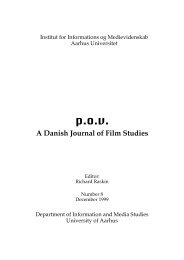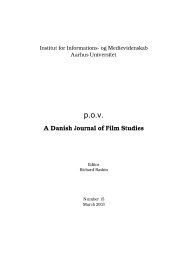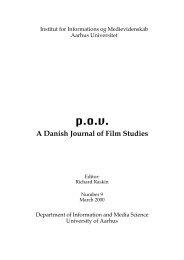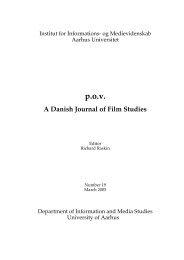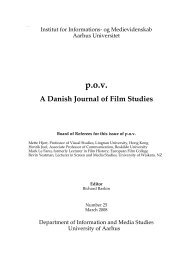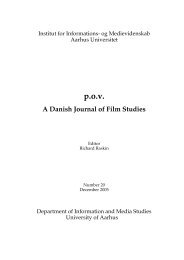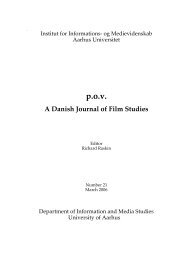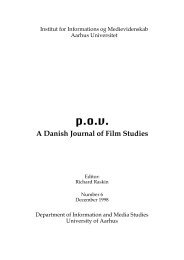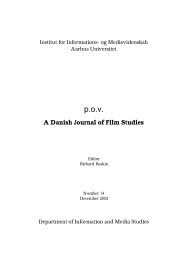The Face of Time - POV - Aarhus Universitet
The Face of Time - POV - Aarhus Universitet
The Face of Time - POV - Aarhus Universitet
Create successful ePaper yourself
Turn your PDF publications into a flip-book with our unique Google optimized e-Paper software.
A Danish Journal <strong>of</strong> Film Studies 79<br />
<strong>The</strong> second part <strong>of</strong> the film establishes a point <strong>of</strong> view just at the<br />
spot where client meets clerk, the glass dividing civic society and<br />
state bureaucracy. In this part <strong>of</strong> the film the focus is mostly from<br />
inside and out, so we see and identify with the clients. However, we<br />
also see the clerk for the first time. In the following parts, the point<br />
<strong>of</strong> view changes rather rapidly between the inside and finally also<br />
the outside view, the clients’ point <strong>of</strong> view on the clerk. Again the<br />
image-sound relation and the framing are very symbolic. Even<br />
though for the first time in the film, we are able to hear speech in<br />
sync and thus identify a client speaking directly to the clerk and<br />
(though without ever seeing lips move) also the clerk answering,<br />
then on and <strong>of</strong>f the film lapses back to the more impersonal <strong>of</strong>fscreen<br />
dialogue. This underlines the inhuman, alienated relation<br />
and conversation. <strong>The</strong> framing <strong>of</strong> the clerk is at the same time just as<br />
symbolic and disembodied as the client’s in the first part. What we<br />
see are hands filling out forms, hands sharpening a pencil, and not<br />
in one shot is it possible to establish a kind <strong>of</strong> direct eye contact<br />
between clerk and client. <strong>The</strong> film only shows facial shots <strong>of</strong> clerks<br />
looking to the side or down.<br />
<strong>The</strong> third and last part <strong>of</strong> the film is even more explicit in its<br />
Kafkaesque view. It starts with the only completely silent sequence<br />
<strong>of</strong> the film. We see the clerk preparing her afternoon tea, and with<br />
the words, “Wait a moment,” all the clients just wait in line, silent,<br />
while she drinks her tea. When the dialogue is resumed we are back<br />
in the completely random relation between dialogue and pictures:<br />
we see a series <strong>of</strong> different people in at the window, but none <strong>of</strong><br />
them speak; the dialogue comes out <strong>of</strong> thin air and seems to live a<br />
life <strong>of</strong> its own. This aspect is gradually underlined and strengthened<br />
by intercuts from the deep backstage <strong>of</strong> the <strong>of</strong>fice, the archive. Here



